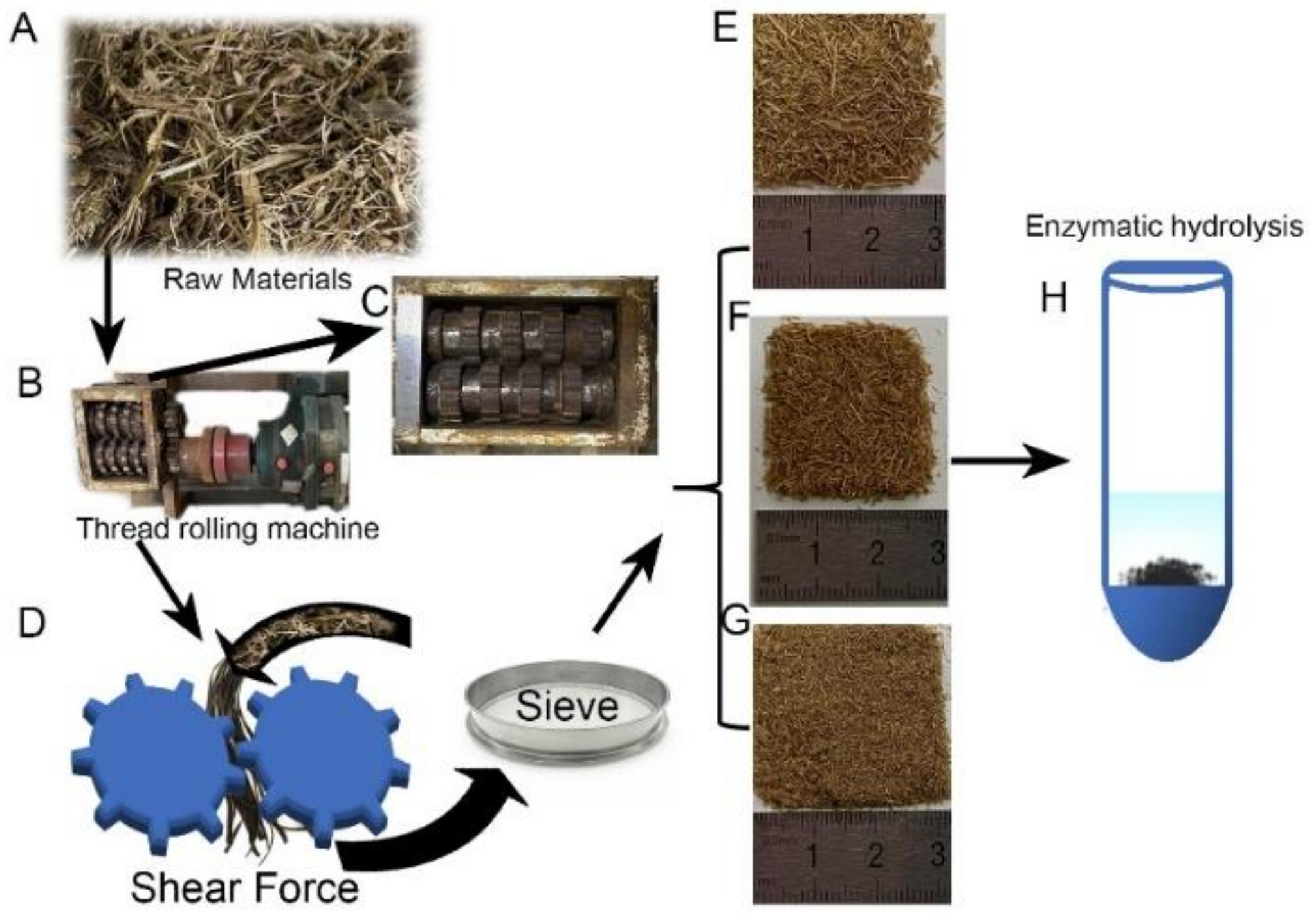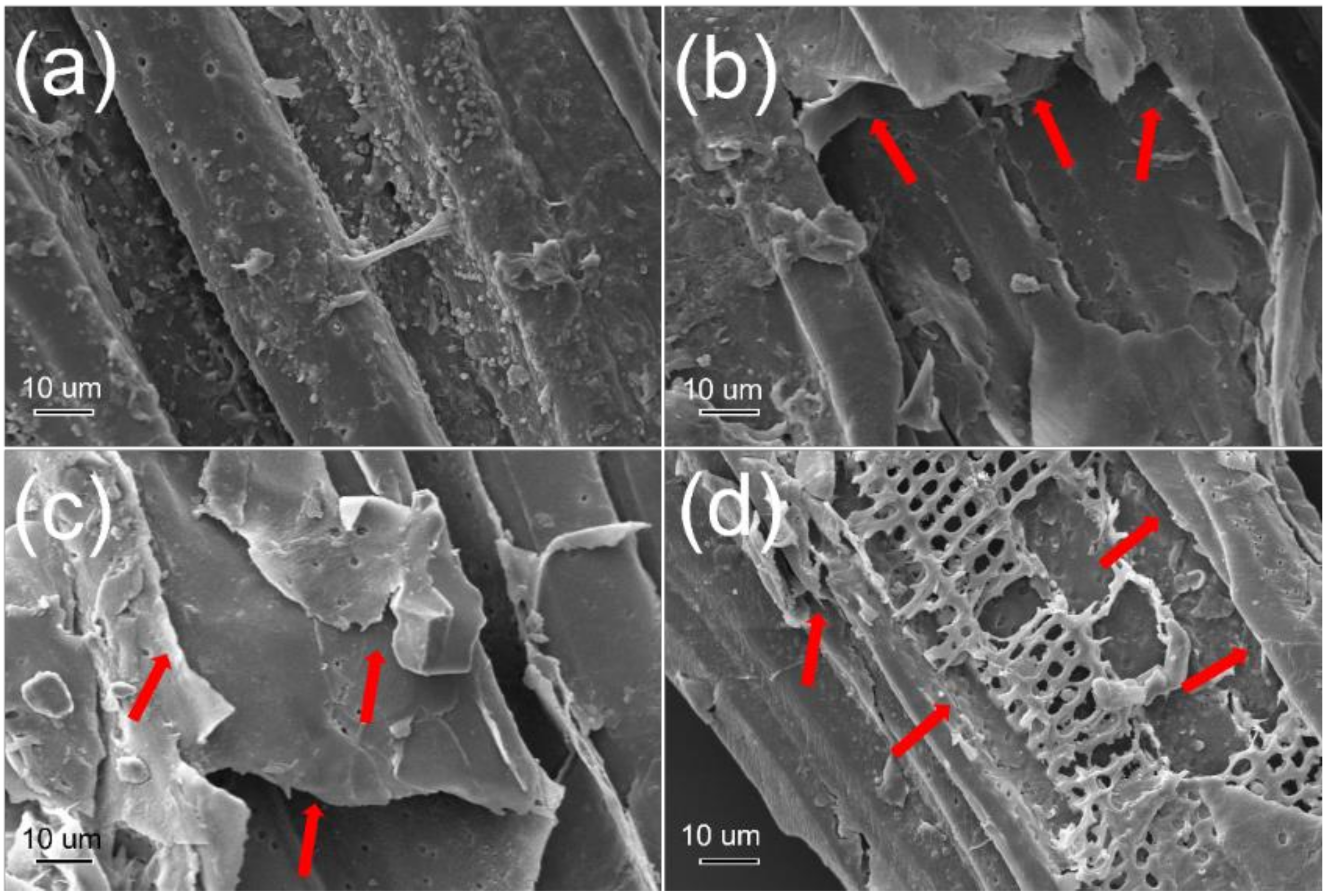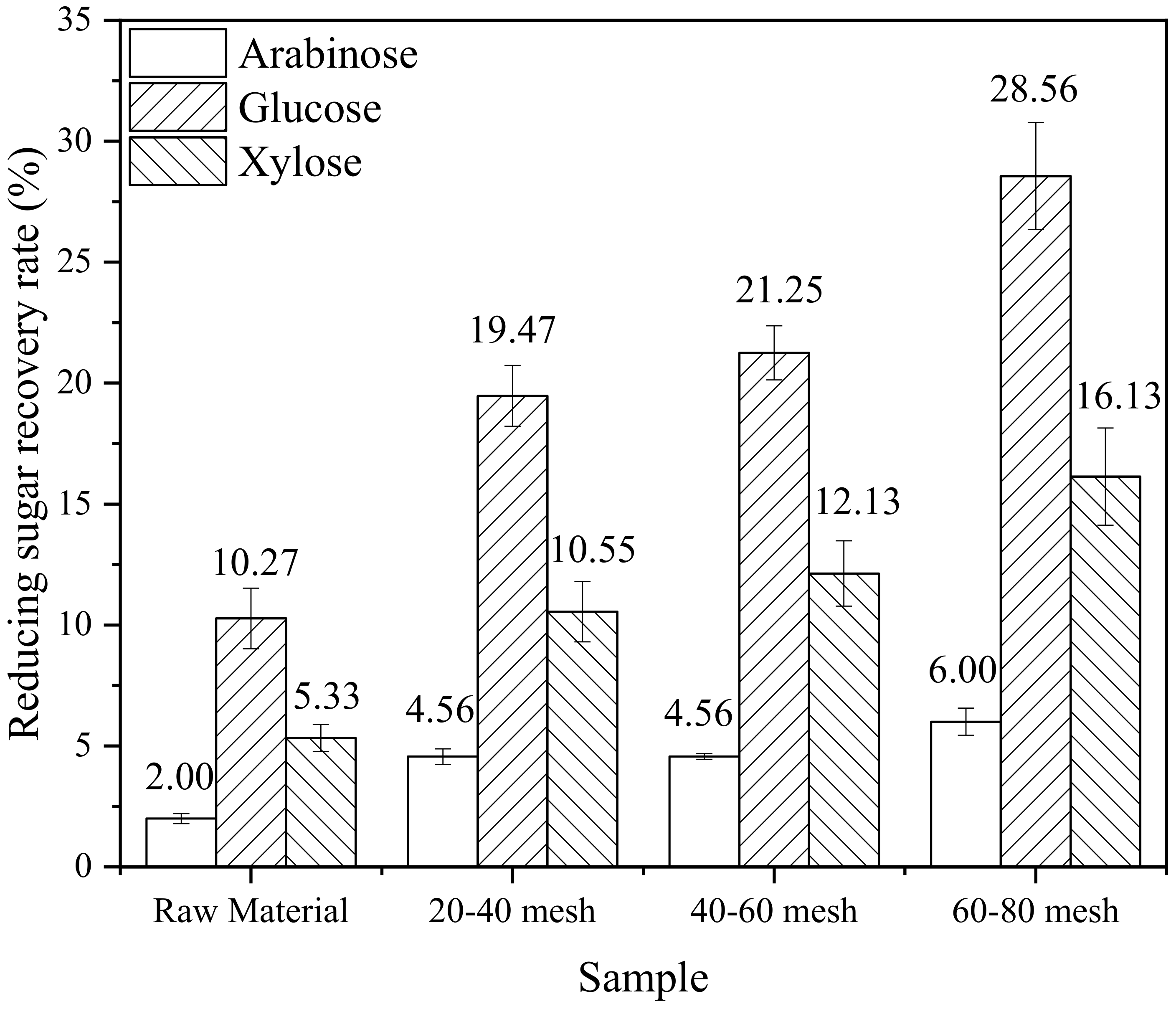Thread Rolling: An Efficient Mechanical Pretreatment for Corn Stover Saccharification
Abstract
1. Introduction
2. Materials and Methods
2.1. Materials
2.2. Thread Rolling Pretreatment
2.3. Enzymatic Hydrolysis
2.4. Physicochemical Characterization of the Corn Stalks and Sugar Cane Bagasse
3. Results
3.1. Mechanism of the Thread Rolling Pretreatment
3.2. The Changes of the Properties of the Thread Rolled Fibers
3.3. Enhanced Biomass Saccharification under Thread Rolling Pretreatment
4. Conclusions
Author Contributions
Funding
Institutional Review Board Statement
Informed Consent Statement
Data Availability Statement
Conflicts of Interest
References
- Deslin, N.; Kubendren, N.; David, L. Ultrasonically-Assisted Dissolution of Sugarcane Bagasse during Dilute Acid Pretreatment: Experiments and Kinetic Modeling. Energies 2020, 13, 5627. [Google Scholar]
- Binod, P.; Sindhu, R.; Singhania, R.R.; Vikram, S.; Devi, L.; Nagalakshmi, S.; Kurien, K.; Sukumaran, R.; Peandey, A. Bioethanol Production From Rice Straw: An Overview. Bioresour. Technol. 2010, 101, 4767–4774. [Google Scholar] [CrossRef]
- Ji, H.; Song, Y.; Zhang, X.; Tan, T. Using a combined hydrolysis factor to balance enzymatic saccharification and the structural characteristics of lignin during pretreatment of hybrid poplar with a fully recyclable solid acid. Bioresour. Technol. 2017, 238, 575–581. [Google Scholar] [CrossRef]
- Karthik, R.; Edward, D.; Varma, V.; Muthusamy, S.; Kumar, G. Updates on the pretreatment of lignocellulosic feedstocks for bioenergy production—A review. Biomass Convers. Biorefin. 2018, 8, 471–483. [Google Scholar]
- Kumari, D.; Singh, R. Pretreatment of lignocellulosic wastes for biofuel production: A critical review. Renew. Sustain. Energy Rev. 2018, 90, 877–891. [Google Scholar] [CrossRef]
- Amarasekara, A.S.; Wiredu, B. A comparison of dilute aqueous p-toluenesulfonic and sulfuric acid pretreatments and saccharification of corn stover at moderate temperatures and pressures. Bioresour. Technol. 2012, 125, 114–118. [Google Scholar] [CrossRef]
- Stephanopoulos, G. Challenges in engineering microbes for biofuels production. Science 2007, 315, 801–804. [Google Scholar] [CrossRef]
- Tsapekos, P.; Kougias, P.G.; Egelund, H.; Larsen, U.; Pedersen, J.; Trenel, P. Mechanical pretreatment at harvesting increases the bioenergy output from marginal land grasses. Renew. Energy 2017, 111, 914–921. [Google Scholar] [CrossRef]
- Han, Y.; Li, J.; Wang, B.; Xu, J.; Zeng, J. Improved enzymatic hydrolysis of tobacco stalk by steam explosion and thread rolling pretreatments. Cell. Chem. Technol. 2015, 49, 181–185. [Google Scholar]
- Sluiter, J.B.; Ruiz, R.O.; Scarlata, C.J.; Sluiter, A.D.; Templeton, D.W. Compositional analysis of lignocellulosic feedstocks. 1. Review and description of methods. J. Agric. Food Chem. 2010, 58, 9043–9053. [Google Scholar] [CrossRef]
- Jin, W.; Chen, L.; Hu, M.; Sun, D.; Li, A.; Li, Y.; Hu, Z.; Zhou, S.; Tu, Y.; Xia, T.; et al. Tween-80 is effective for enhancing steam-exploded biomass enzymatic saccharification and ethanol production by specifically lessening cellulase absorption with lignin in common reed. Appl. Energy 2016, 175, 82–90. [Google Scholar] [CrossRef]
- Anu, A.K.; Alexander, R.; Gotthard, K.; Sanjeev, K.; Davender, S. Multifarious pretreatment strategies for the lignocellulosic substrates for the generation of renewable and sustainable biofuels: A review. Renew. Energy 2020, 160, 1228–1252. [Google Scholar] [CrossRef]
- Hui, Y.; Gao, Y.; Yang y Fang, G.; Dai, H. Improving cellulose nanofibrillation of waste wheat straw using the combined methods of prewashing, p-toluenesulfonic acid hydrolysis, disk grinding, and endoglucanase post-treatment. Bioresour. Technol. 2018, 256, 321–327. [Google Scholar]
- French, A. Idealized powder diffraction patterns for cellulose polymorphs. Cellulose 2014, 22, 885–896. [Google Scholar] [CrossRef]
- Chang, G.; Tae, H. Advancements in Catalytic Conversion of Biomass into Biofuels and Chemicals. Energies 2020, 13, 5438. [Google Scholar]
- Jiang, J.; Wang, J.; Zhang, X.; Wolcott, M. Microstructure change in wood cell wall fracture from mechanical pretreatment and its influence on enzymatic hydrolysis. Ind. Crops Prod. 2017, 97, 498–508. [Google Scholar] [CrossRef]
- Abidi, N.; Cabrales, L.; Haigler, C. Changes in the cell wall and cellulose content of developing cotton fibers investigated by FT-IR spectroscopy. Carbohyd. Polym. 2014, 100, 9–16. [Google Scholar] [CrossRef]
- Safari, A.; Karimi, K.; Shafiei, M. Dilute alkali pretreatment of softwood pine: A biorefinery approach. Bioresour. Technol. 2017, 234, 67–76. [Google Scholar] [CrossRef]
- Zhu, M.; Wang, Z.; Wen, J.; Qiu, L.; Zhu, Y.H.; Su, Y.; Qin, W.; Sun, R. The effects of autohydrolysis pretreatment on the structural characteristics, adsorptive and catalytic properties of the activated carbon prepared from Eucommia ulmoides Oliver based on a biorefinery process. Bioresour. Technol. 2017, 232, 159–167. [Google Scholar] [CrossRef]





| Samples | Samples | Specific Surface Area (m2/g) | Pore Volume (cm3/g) | Pore Size (nm) |
|---|---|---|---|---|
| entry 1 | Raw Material | 3.16 | 0.002 | 2.88 |
| entry 2 | 20–40 mesh | 5.26 | 0.003 | 3.31 |
| entry 3 | 40–60 mesh | 7.86 | 0.006 | 4.62 |
| entry 4 | 60–80 mesh | 10.58 | 0.010 | 5.32 |
Publisher’s Note: MDPI stays neutral with regard to jurisdictional claims in published maps and institutional affiliations. |
© 2021 by the authors. Licensee MDPI, Basel, Switzerland. This article is an open access article distributed under the terms and conditions of the Creative Commons Attribution (CC BY) license (http://creativecommons.org/licenses/by/4.0/).
Share and Cite
Deng, L.; Li, J. Thread Rolling: An Efficient Mechanical Pretreatment for Corn Stover Saccharification. Energies 2021, 14, 542. https://doi.org/10.3390/en14030542
Deng L, Li J. Thread Rolling: An Efficient Mechanical Pretreatment for Corn Stover Saccharification. Energies. 2021; 14(3):542. https://doi.org/10.3390/en14030542
Chicago/Turabian StyleDeng, Likang, and Jun Li. 2021. "Thread Rolling: An Efficient Mechanical Pretreatment for Corn Stover Saccharification" Energies 14, no. 3: 542. https://doi.org/10.3390/en14030542
APA StyleDeng, L., & Li, J. (2021). Thread Rolling: An Efficient Mechanical Pretreatment for Corn Stover Saccharification. Energies, 14(3), 542. https://doi.org/10.3390/en14030542





